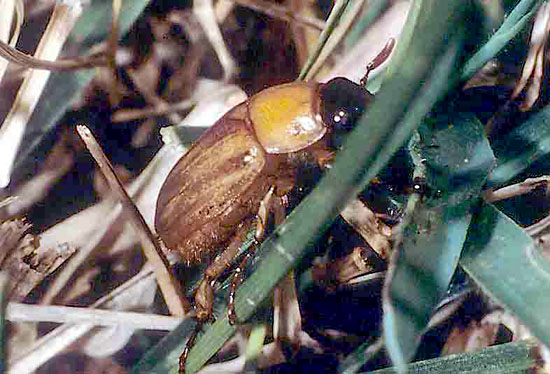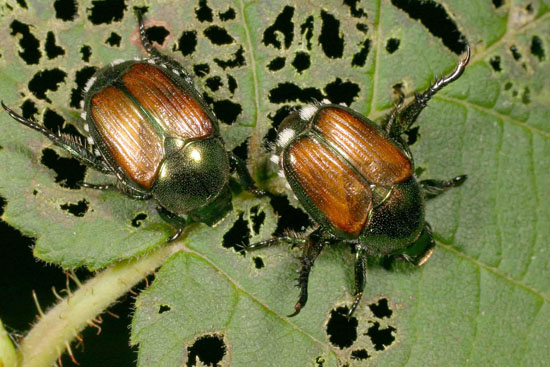Issue 11, July 11, 2016
White Grubs
White grub eggs are primarily laid during the first half of July. In southern Illinois, most of the eggs have been laid; in northern Illinois, many of the eggs will be laid during the next couple of weeks. Where these eggs are laid and how many are laid rely on several factors, which determine whether preventative insecticides need to be applied to turf during July.
Rainfall is the dominant factor in Illinois in most years. Adult Japanese beetles and masked chafers are attracted to moist soil with green turf to lay their eggs which hatch into white grubs by early August. If non-irrigated turf is dry and brownish, the beetles fly to moist, green, irrigated areas to lay their eggs, resulting in high grub numbers in those d turf is green and thareas. If non-irrigatee soil is moist, the beetles will lay their eggs in most turf areas, typically resulting in few white grubs per square foot usually do not requiring treatment.

Masked chafer adult.
Moist soils are also beneficial to insect-specific fungi that kill white grub larvae. High moisture levels during August and September not only help the turf replace roots eaten by white grubs, white grub numbers commonly decline from fungal diseases.
Rainfall has been adequate in east central, north central, northeastern, and much of northwestern Illinois in June, resulting in non-irrigated turf being green and attractive to white grub beetles. Preventative treatments in these areas are likely to be unnecessary. However, southern, western, and central Illinois have been dry, and white grub eggs are likely to be numerous in irrigated turf in those areas of the state.
Adult white grub population sizes are also factors. The severe season-long drought of 2012, the summer drought in 2013, and the severe cold winter that followed decimated the Japanese beetle population throughout the state. Northern and southern masked chafers, also known as annual white grubs, handle summer drought and deep frozen soils during the winter much better than Japanese beetle. With the reduction in Japanese beetles for the past few years, masked chafer numbers have risen as they don’t seem to be able to compete well with Japanese beetles on a level playing field.
Japanese beetle adult numbers are higher this year than they have been since 2012. Their recent rise means that we currently have large numbers of Japanese beetles and still have high numbers of northern and southern masked chafer beetles. There will be no shortage of white grub eggs laid this month.

Japanese beetle adults.
Hot, dry soils are additional factors in white grub numbers. Turf root zone temperatures of 87 degrees F and above greatly reduce white grub egg hatch. Newly-laid white grub eggs greatly increase size from absorbing surrounding moisture. If they are laid into dry soil, most eggs die. Throughout the two to three week egg stage, dry soils at or below the wilting point cause high egg mortality. This year, even in drier areas of the state and areas that were very hot, soil moisture and temperature probably are having little effect on white grub egg hatch.
Preventative white grub insecticide applications are generally justified to irrigated turf in western, central, and southern Illinois. An application of a long-lasting insecticide such as chlorantroniliprole (Acelepryn), cyantraniliprole (Ference), or one of the neonicotinoids imidacloprid (Merit), clothianidin (Arena), or thiamethoxam (Meridian) can be made during July. Do not apply Ference or neonicotinoids to turf with blooming weeds or flowers to avoid killing pollinators.
In east central, north central, northeastern, and much of northwestern Illinois, it is better to wait until August, and apply insecticide during the first half of August where scouting of hatched white grubs reveals damaging numbers. (Phil Nixon)
Author:
Phil Nixon